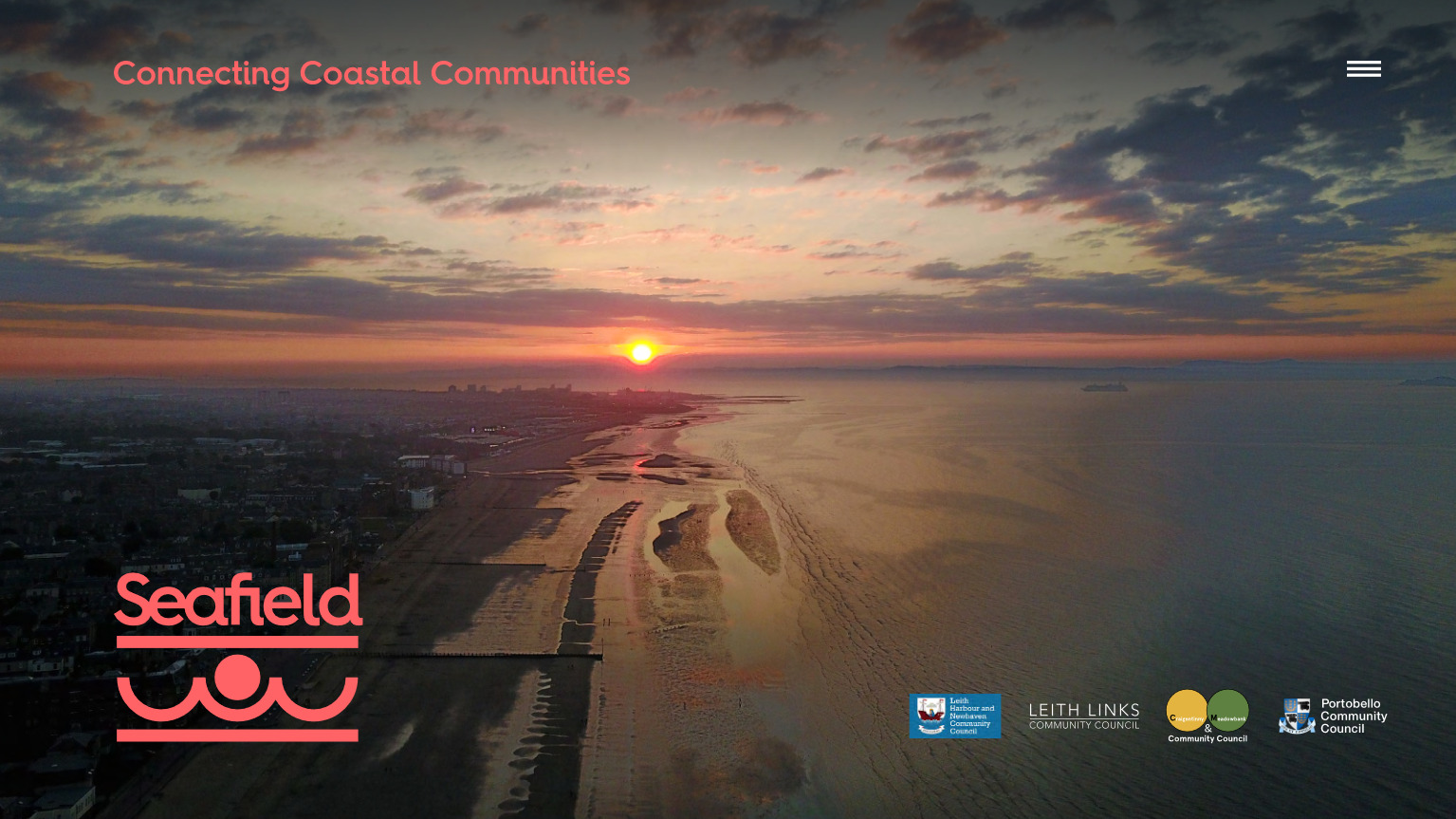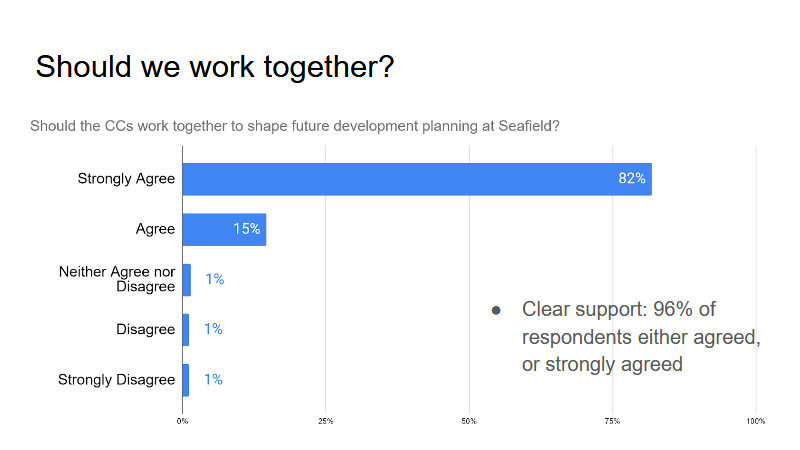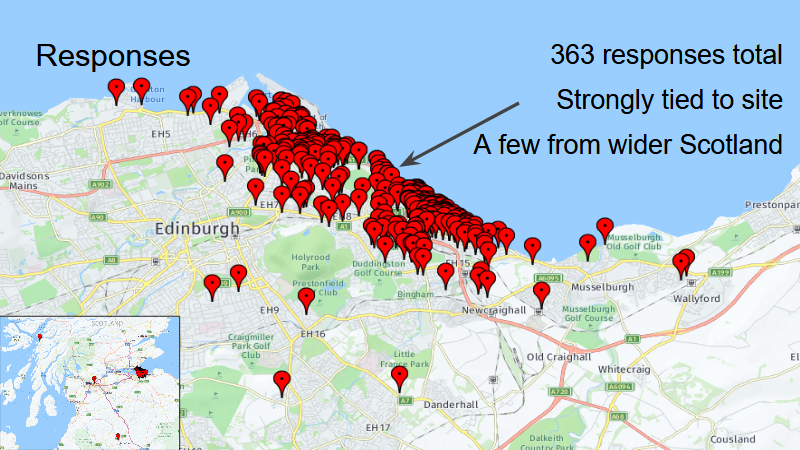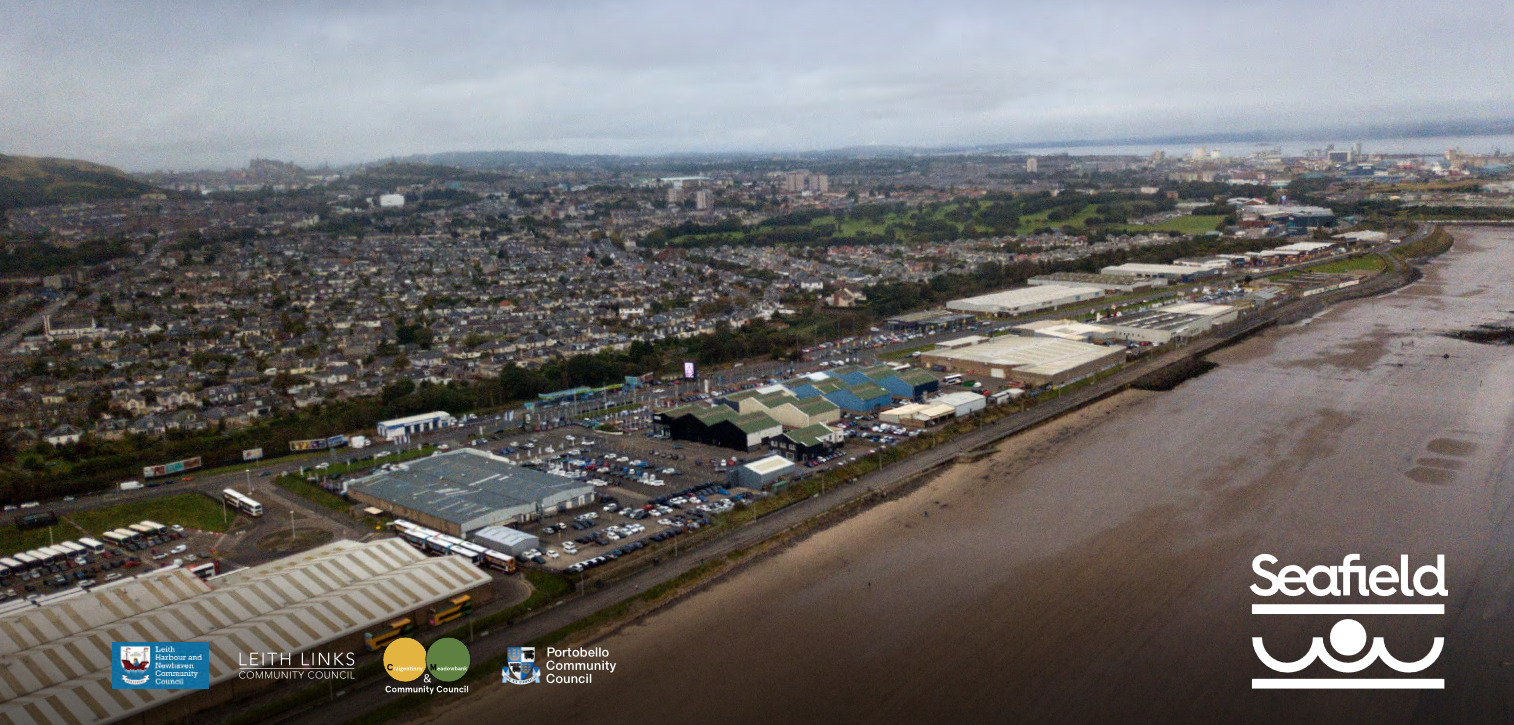We have been working with neighbouring community councils, ahead of Seafield being likely allocated for housing in the forthcoming City Plan 2030. This is an update on that work.

The City of Edinburgh Council is proposing to allocate Seafield as an “urban area housing-led mixed-use site” in the next local development plan (City Plan 2030).
This presents the city, and in particular the communities adjacent to the site, with a number of exciting opportunities. And it simultaneously poses a number of threats.
Seafield: Connecting Coastal Communities (S:CCC) is the name we have given to a shared endeavour to transform a 1.2 km stretch of industrial brownfield into an outstanding new shoreline village with homes, green space, leisure and job opportunities.
If done well, this unique coastal location could become one of Edinburgh’s ‘pearls’, creating access to the shore, an improved and extended Promenade helping connect Portobello and Leith, and providing wonderful physical surroundings for living, and for outdoor activity. The development also offers much needed options for new and better transport connections to the city centre and between the coastal communities. A new “20 minute neighbourhood” with a centrally located facilities, shops and workspaces could help support a sizeable new community.
The potential development, if done badly and with a lack of community input, threatens to leave us with ugly and uncoordinated development, with a lack of supporting infrastructure. Poorly planned housing, streets, and open spaces combined with a lack facilities and infrastructure also has the potential to over-burden our existing communities.
Such an approach may serve the short-term interests of developers, but it will not be to the long term benefit of those who live there, or to the local communities adjacent to the site or to the city as a whole.
The four community councils that border the area are working together to seek to ensure that the potential of this site is maximised. It takes “more than houses to make a community” has been a welcome mantra from some of our elected Councillors, and we welcome that message. We are therefore committed to helping the city and our communities deliver a mixed use development that will inspire and benefit us all. There is a clear and strategic need for social (education, employment, health) and transport infrastructure and high-quality public amenity and open space, which creates a liveable and sustainable built environment.
To ensure that all the potential development is coordinated and aspires to the highest standards, we aim to co-produce with City of Edinburgh Council a Place Brief and Masterplan that will deliver a highest-quality environment for present and future generations.
We recognise that it is of critical importance that all our communities are appropriately engaged and given full opportunity to share their views and local knowledge, to best shape future development at Seafield. We propose that our community councils work with the Council to define the processes that will lead to meaningful community engagement on the potential issues and opportunities in the area. In doing so we will always seek to raise issues of importance for the communities, bringing them to the attention of the Council, the design teams, landowners, developers, and others involved in the delivery of change for the Seafield area.
In our dealings with others, including wider stakeholders (such as Scottish Water, SEPA, Sustrans, and NatureScot), we will seek to clearly voice the views of the communities. We will however be seeking to work positively and collaboratively with all. We recognise that there is an important opportunity to bring a collective vision to positive fruition. 
We are:
- Craigentinny and Meadowbank Community Council
- Portobello Community Council
- Leith Links Community Council
- Leith Harbour & Newhaven Community Council
We are also in the process of forming a Special Purpose Vehicle (a company limited by guarantee) to act as the community lead body throughout this process, to enable our four communities to undertake shared tasks that may be necessary. This will make it easier for us to apply for funding, tender for contracts for planning consultants and architects. and it will offer all other key stakeholders a single point of contact for community interests.
What have we done so far?


Firstly, as a collective of four community councils, we sought community approval for our work. This established a broad level of support for our work and gave us a valuable initial insight into the matters of most interest for local people. We began to meet together regularly and co-ordinate our efforts to help support the community council that will be most directly affected by the development, Craigentinny and Meadowbank. We have held positive meetings with the City of Edinburgh Council and the Scottish Government, raising the need for a co-ordinated and planned approach to future change and highlighting the need for community engagement and representation in decision making., While we have strong levels of professional skills within our communities we are talking with architects, planning consultants and others that have award winning experience of masterplanning large sites. We held a positive meeting with our locally elected representatives (MPs, MSPs, Councillors) and all have expressed support for our initiative.
Perceptions of Seafield are going to change

At the moment, the word ‘Seafield’ for most people with any local knowledge of Edinburgh conjures up images of a sewage plant, a load of car dealerships, and a cat and dog home. We intend to promote a deeper understanding of its past heritage, community identity, and social history and we will draw on this when we look to explore and redefine the future of Seafield. We know that people greatly value the beach and the coastal location but also recognise that climate change and rising sea levels are going to have an impact on the area in the coming years.
We accept that there is a great and urgent need for more housing in Edinburgh, so we expect to see plans for high density but high quality social and affordable housing. We will explore opportunities with the Council, Scottish Government, developers, housing providers and landowners for new models of social and affordable housing and innovative methods for delivery- such as co-operatives, co-build and direct community ownership.
But this has to be much more than a housing development. Seafield presents us with an opportunity to open up a unique waterfront area for recreational, cultural, residential, business and commercial use – with an emphasis on connected green and blue spaces and integrated public spaces along the waterfront. To make this a sustainable development we recognise there will need to be a transformation of the currently poor level of public transport provision in the area, and we will need ensure that cycling and walking provision is fully integrated within the areas, with positive links to wider networks.
The City Plan 2030 (in development)
The timing is right for a partnership between the local communities and the City of Edinburgh Council. The Council has made a commitment to help create “strong, sustainable and healthier communities, enabling all residents to enjoy a high quality of life.” (Part 1, Section 1, Choices for City Plan 2030)
The Council states that “good design can help achieve a wide range of social, economic and environmental goals, creating places that are successful and sustainable.” (Part 1, Section 2, Place Making and Design, Choices for City Plan 2030)
The draft local plan favours the use of brownfield sites over greenfield sites for future development, to meet the city’s growing and expanding population. It is recognised that new ‘urban areas’ on a large brownfield site (such as at Seafield) would “require new and significant changes to existing infrastructure – schools, healthcare and transport…”. The process of co-ordinating and delivering change may not be easy and the Council states “This approach will require a significant step change in the delivery of urban land in Edinburgh. The proposed approach will require joint ventures with our partners and commercially, with the option of compulsory purchase where required, to deliver on 275 hectares of current employment land for housing led mixed use development.”
If others can achieve great places, so can we
Other countries have managed to transform neglected waterside industrial land into modern developments that are both highly liveable and architecturally exciting, and that include appealing public green and blue spaces.
Our neighbours in Scandinavia lead the way with Stockholm, Gothenburg and Copenhagen, to name but a few. Cities in France, Germany and the Netherlands demonstrate bold design that is valued by its citizens, providing well designed public/community spaces, and an aspiration to carbon-free living.
Immediate tasks
- 1. Local Interests: the formal establishment of a Special Purpose Vehicle (SPV), involving the community council in whose area this site sits – Meadowbank and Craigentinny – with its three neighbours, Portobello, Leith Links and Leith Harbour.
- 2. A Local Housing Agency: all development, whether integrated or piecemeal, will require an affordable housing component of at least 25% of the new-build homes – although the Council hopes to establish a 35% requirement.
S:CCC has begun to hold exploratory discussions with housing associations with the aim of being able to offer developers a model that would enable their affordable plus mixed-use requirements to be delivered.
In whatever form it takes, the Housing Agency will be encouraged to develop specifications for a mix of low-carbon, healthy construction and social homes, integrated with home-working and co-housing facilities and interspersed with sites for collective self-build.
- 3. “A Connectivity-led, Land Value-Captured Masterplan”. One of our advisers, George Hazel is a transport and Edinburgh expert, and has evolved models for developers to share, and thus fund, the added value that new light rail infrastructure brings to integrated development. The Seafield site has an unused train track which connects, to the east, to Edinburgh’s South Suburban Loop, and to the west runs close to the currently on-site Constitution Street section of the Edinburgh Tram extension.
This link, reopened, would connect a growing population into Edinburgh’s green network, while providing developers with the greatly raised land values which should drive their commitment to the timescales and cooperative masterplans the communities seek.
Next Steps:
- Seeking Council and developer buy-in and commitment to our collective aspirations for this critically significant site
- Seeking Scottish Government support for this locally led initiative to jointly develop with the City of Edinburgh Council a Master Plan for Seafield as an exemplar of the community led place-making aspiration
- Find out what issues are important for the communities in realising change and development across the Seafield site
- Establish a clear process and timetable for the preparation of the Place Brief and Masterplan, with clearly defined opportunities for community participation and engagement in the proposals
- Work with the Council to recruit a design team to deliver said Masterplan
Note: to date the four community councils have been in receipt of pro bono advice and technical support from Malcolm Fraser of Fraser/Livingstone Architects.
